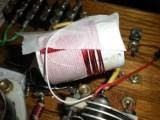Searching on the internet does not show up many results on how to go about this organization of a workshop and associated components. I thought that someone may find it useful to follow my project as I proceed and as I 'learn by doing'.
I first laid out all my small components on my workbench. This allowed me to see what I have and to determine what size component storage I will need. I have also now embarked upon a mission to collect as many empty containers from the household trash as possible. Having paid a visit to the local container store I realize that most of those containers are far too expensive. Purchasing these containers would cost as much as the components for a complex radio would cost! I did go to Dicks Sports Store and purchased a number of fishing lure boxes for about $5.66 each. These provide about 34 storage bins for small components such as resistors and capacitors.
I started my organization with the capacitors. I soon figured out that the most efficient scheme would be to store components in designated BINS. Then link the BIN number to details about the components in a catalog on an excel spreadsheet. Having ironed out a few bugs I believe I now have a good and practical set up. Essential to the operation of the catalog is the ability to search. This means that even though the BIN numbers may be illogically numbered from a components perspective, at least it is possible to cross reference and search for the desired component. I have, to date, recorded approx 550 capacitors in the system and already this has given me insights into the power of a searchable catalog. The result of this project will be that all components will be searchable through the excel spreadsheet mechanism. This will enable me to quickly and painlessly try different components in the circuit in order to optimize my design.
To catalog a component my method works as follows. Using capacitors as an example:
Identify the capacitor spreadsheet in the excel components book.
Identify the capacitor value that requires storage.
Type in the capacitor value into the 'Find' function on the catalog spreadsheet. eg. 100pf. Typed in as '100'. If the value is greater than 999pf then type the value as mfd or microfarads. For example .001 as opposed to 1000pf. (Note that I need to note this rule on my catalog notes section.) Only type the number. Not pf or mfd.
If the computer shows a result I then increment the 'quantity' column, add any other known information such as tolerance or max working voltage.
I then identify the BOX number and the BIN number within that box from the spreadsheet.
Locate the BOX and the BIN and store the component if there is enough room in the BIN.
If there is not enough room or the component is a new component. Open a new line item in the spreadsheet and allocate a new BOX/BIN number. Enter the details of the component.
Store the component in the BIN.
To look for a component simply use the FIND feature on the spreadsheet to locate the component. Then if the component is removed then decrement the quantity in that BIN. If the BIN becomes empty then enter a replacement component requirement in the 'COMPONENTS TO BE ORDERED' Spreadsheet. The same procedure would apply to the case where a component cannot be located. In this case the Component should be added to the COMPONENTS TO BE ORDERED SPREADSHEET.
This method is very efficient from a space point of view since it allocates BINS only for components that exist. Since space is at a premium in my workshop I cannot afford to have empty BINS just in order to adhere to a logical list. The problem is that components of the same category. ie Capacitors may exist in many different boxes. However the computer search feature will find the BOX and the BIN. It means that the computer becomes essential to the operation of the system. The BOXES and BINS are only marked with a Number for the Box and a letter for a BIN within a box. This means that by looking at the BOX you cannot necessarily see inside what is in it. Another benefit of this system is that it is very easy to redesignate a BIN for another type or component. It is just a matter of changing the entry in the computer.
No doubt there are catalog systems available out there. I thought that by developing my own I would have a very clear idea of what type of catalog system I need. Once I know this I can transfer my data over to another more robust and user friendly system. Should not be a problem.
Once I have all my existing components cataloged and therefore some control over my workshop environment I will then look at storing the catalog on my website in order to be able to access from any computer. This will be particularly useful when I am on the road and I am working on a design for a project. Having a master database online will mean that I do not have to contend with the headache of keeping multiple versions up to date.


